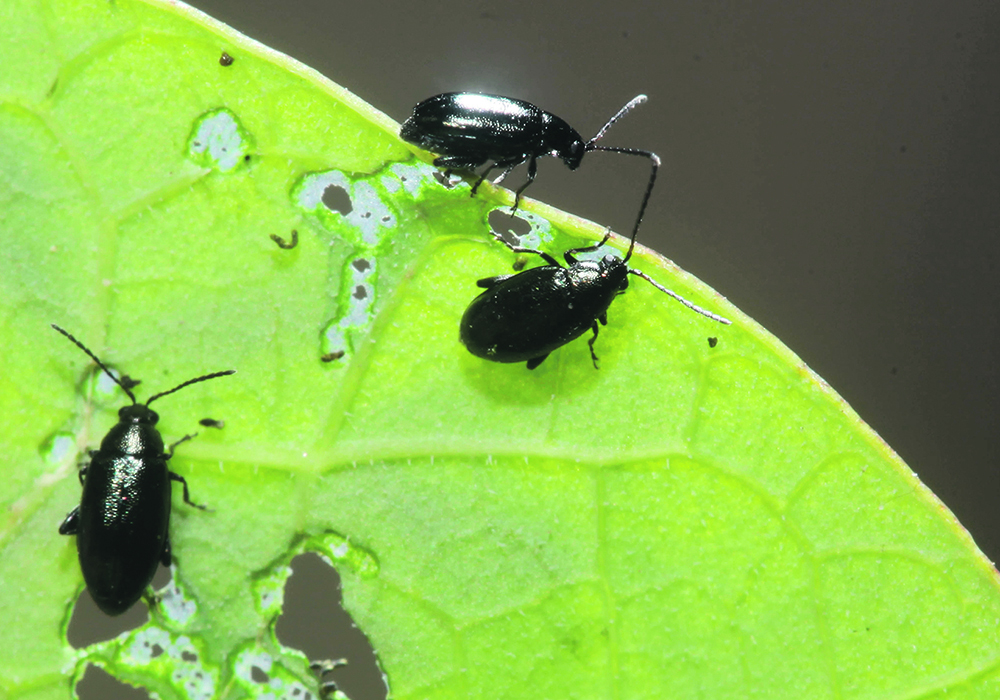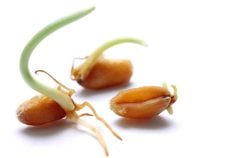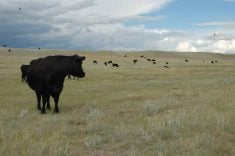Flea beetles seem to get worse every year. Now, new research is trying to find out why.
Last May and June, the pests devoured thousands of canola fields in Western Canada, forcing hundreds of farmers to re-seed their crops. A much larger number of growers applied foliar insecticides to kill the beetles because the population was out of control.
Last year was especially bad, thanks to dry soils and frost, followed by 30 C temperatures in June. As a result, canola germinated and emerged slowly across the Prairies, so flea beetles had more time to munch on sensitive canola seedlings.
Read Also

Manitoba community projects get support from HyLife
HyLife Fun Days 2025 donated $35,000 each to recreation and housing projects in Killarney, Steinach and Neepawa earlier this fall.
The growing conditions last year were extreme, but it’s hard to recall a spring when flea beetles weren’t a major problem for canola growers in Western Canada.
Several years of difficult spring weather, with colder than usual temperatures, could be causing most of the flea beetle problems.
Another factor is that flea beetles now have more canola to eat, which sustains a larger population of the pests. In 2006, Canadian farmers seeded about 14 million acres of Canada. Since 2012, canola acres have consistently reached 21 to 22 million acres.
As well, flea beetles may have developed resistance to neonicotinoid insecticides. The neonics, which are coated onto every canola seed, may now be less effective than they were in the early 2000s.
“One of the questions that is floating around, people wonder is there resistance … to the clothianidin and thiamethoxam. They’ve been on the market for 20 years. The insect population has been exposed to it, year over year,” said Krista Anderson, an agronomic adviser with Bayer CropScience Canada.
“The answer is possibly, but we don’t know for sure…. No one has actually looked for the mutations in the flea beetles to see if they have that ability to overcome the insecticides.”
No one has looked, until now.
Boyd Mori, an assistant professor in the agriculture, food and nutritional science department at the University of Alberta, is leading a three-year project to understand if flea beetles are resistant to neonic insecticides.
Results Driven Agriculture Research (RDAR), the Alberta Canola Producers Commission, the Western Grains Research Foundation, Bayer and Syngenta are funding Mori’s research.
In the lab, Mori and his team will conduct cage experiments with 25 canola seedlings.
Fifty flea beetles will be added to each cage.
“(We’re) growing (canola) seedlings and then exposing them to flea beetles,” said Mori, an entomologist who studies integrated pest management and sustainable pest control.
“Then, we’re monitoring that for three days (to check) damage and death of the flea beetles.”
The study was supposed to begin in 2021, but the pandemic made it difficult to hire staff and operate laboratories at the university.
So, this spring, Mori and his colleagues will collect flea beetles from multiple locations across the Prairies — likely one location in Manitoba, two in Saskatchewan and three or four in Alberta.
“It doesn’t sound like a lot, but we’re testing three or four different products, plus a fungicide-treated seed (without neonics) and a totally untreated seed,” he said.
“(We’re) also testing some of the newer products, like Buteo Start from Bayer… and a couple of the Syngenta products.”
Mori and his team will also be looking for differences in the two main types of flea beetles on the Prairies — the crucifer and striped.
Previous research has shown that striped flea beetles are more tolerant of neonicotinoid insecticides. But the striped population didn’t develop resistance because of repeated exposure to neonics.
“We don’t even call it resistance in flea beetles,” Mori said. “The striped flea beetles already have a natural mechanism … that helps them tolerate the neonicotinoids.”
That may explain, at least partially, why flea beetles have become more problematic for canola growers.
The geography of striped flea beetles has been expanding. At one time they were mostly found in the Parkland region of the northern Prairies, but Agriculture Canada research indicates their range now includes the central and southern parts of the Prairies.
Striped flea beetles could be flourishing because of their natural tolerance to neonics, but no one knows for certain. Maybe crucifer flea beetles have developed resistance to neonics.
“Because we do have all these acres grown with a seed treatment, is that adding increased selective pressure on them and transforming these populations?” Mori said.
Besides monitoring the number of flea beetles that die and those that don’t, the researchers want to understand how the beetles are resistant to the insecticides.
To do that, they will study the genetics of beetles that still exist after eating canola seedlings with neonic insecticides in the plant’s tissue.
“Why (can) these flea beetles feed on neonicotinoid treated seed and survive?” Mori said.
“Are there increased levels of detoxication genes?”
Mori hopes to publish full results and answer such questions by 2024.
In the shorter term, he expects to have some data from the first year of the experiment by late summer or more likely in the fall.
















